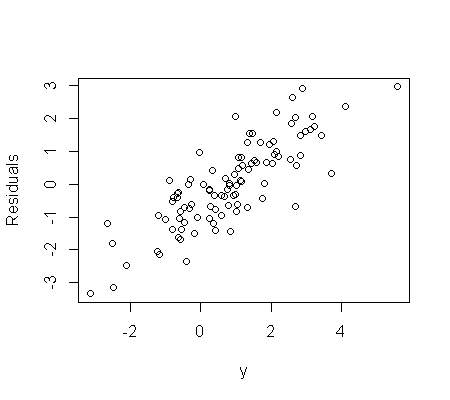1) Residuals do correlate positively with observed values in many, many cases. Think of it this way - a very large positive error ("error" is the "true residual", to misuse the language) means that the corresponding observation is, all other things equal, likely to be very large in a positive direction. A very large negative error means that the corresponding observation is likely to be very large in a negative direction. If the $R^2$ of the regression is not large, then the variability of the errors will be the dominating effect on the variability of the target variable, and you will see this effect in your plots and correlations.
For example, consider the model $y_i = a + x_i + e_i$, which we'll model as $y_i = a + bx_i + e_i$, (which is correct for $b = 1$.) Here's the result of a regression with 100 observations:
e <- rnorm(100)
x <- rnorm(100)
y <- 1 + x + e
foo <- lm(y~x)
plot(residuals(foo)~y, xlab="y", ylab="Residuals")
> summary(foo)
Call:
lm(formula = y ~ x)
Residuals:
Min 1Q Median 3Q Max
-3.3292 -0.8280 -0.0448 0.8213 2.9450
Coefficients:
Estimate Std. Error t value Pr(>|t|)
(Intercept) 0.8498 0.1288 6.600 2.12e-09 ***
x 0.8929 0.1316 6.787 8.81e-10 ***
---
Signif. codes: 0 ‘***’ 0.001 ‘**’ 0.01 ‘*’ 0.05 ‘.’ 0.1 ‘ ’ 1
Residual standard error: 1.286 on 98 degrees of freedom
Multiple R-squared: 0.3197, Adjusted R-squared: 0.3128
F-statistic: 46.06 on 1 and 98 DF, p-value: 8.813e-10

Note that we achieved a fairly respectable (in some fields) $R^2$ of 0.32.
We can obscure this effect with a different model:
y <- 1 + 5*x + e
foo <- lm(y~x)
plot(residuals(foo)~y, xlab="y", ylab="Residuals")
which has an $R^2$ of 0.93 and the following residual plot:

Here the correlation between $y$ and the residuals is about 0.25, but it's a lot less obvious on the plot.
2) Residuals have correlation zero with fitted values in a linear regression, by construction. Is your statement "... weakly correlated with fitted Y negatively" based solely upon looking at the plot, or did you actually calculate the correlation? If the former, appearances can be deceiving... if the latter, something is wrong; possibly you aren't looking at what you think you're looking at.


